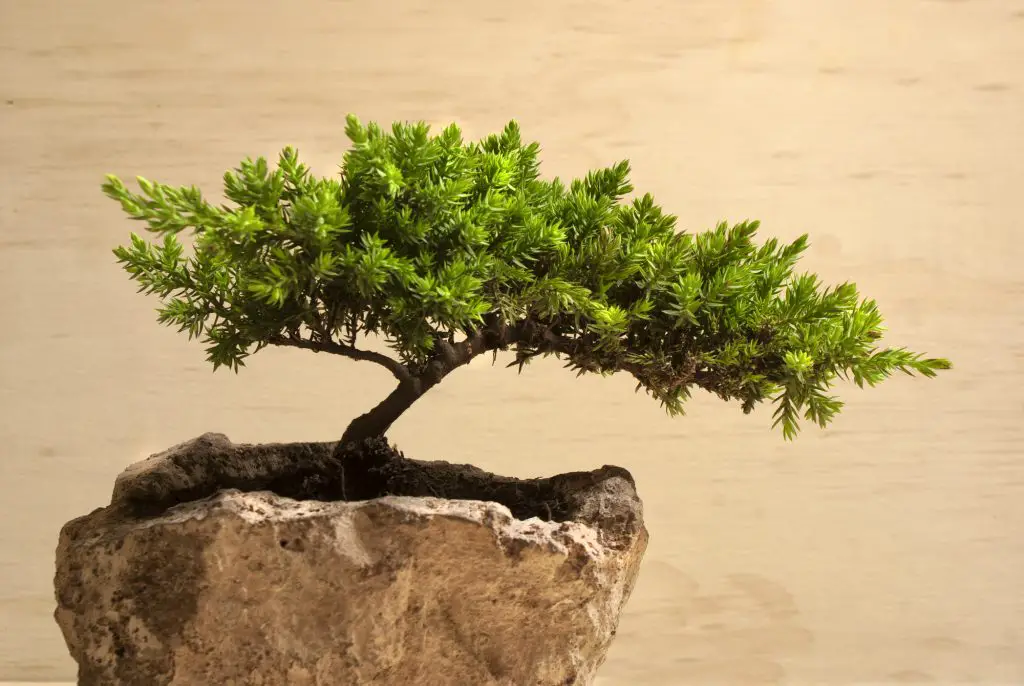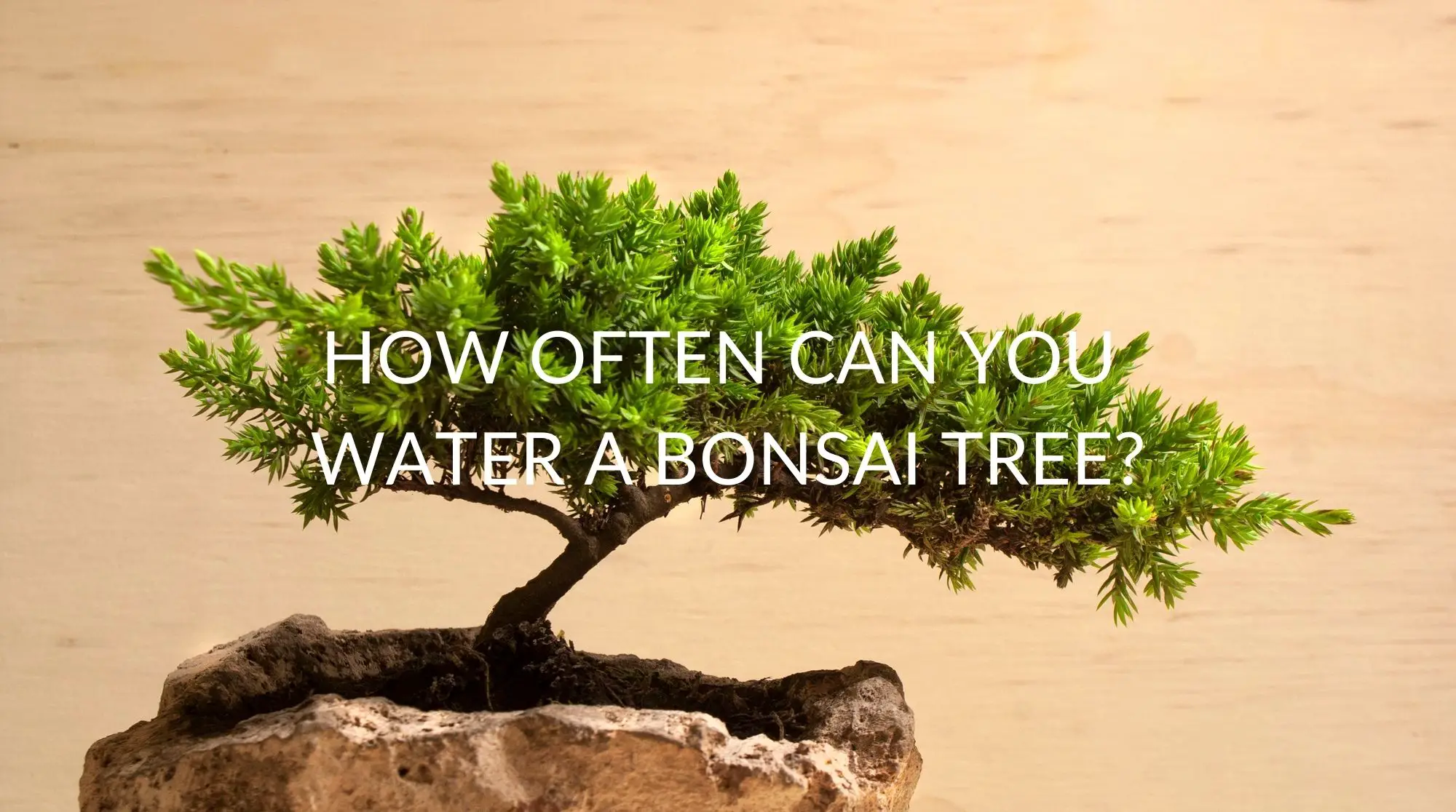The water requirements of a Bonsai tree vary depending on the size and species of tree, the season, the climate, and pot size. The best way to determine how often you should water your Bonsai Tree is to check the soil regularly. Generally, a Bonsai requires water when the top half-inch (1cm) of soil is dry.
It is incredibly important to the health of your Bonsai Tree that you water it adequately. This means not overwatering or underwatering.
You will need to understand the species of your tree in order to know how much to water it.
In addition, you will need to keep track of what conditions your tree is growing in–how much light it receives, whether it has adequate drainage, whether the climate is dry or damp, among other things, in order to predict how much water to give your Bonsai.
There are no “rules” about watering. If you received instructions with your tree, start with those, but there is no substitute for monitoring your tree to figure out its water needs. Read on to discover how to be an expert at watering your Bonsai Tree!
How Much Water Does A Bonsai Need Per Day?
Any tree can be a Bonsai Tree, so just like with other houseplants, certain types of trees need more water than others. It is crucial that you do not allow your Bonsai to dry out completely. But how much water should you give it?
Bonsai also don’t like to be overwatered–they need to have adequate drainage in their pot and soil. Bonsais do not like to sit in wet or soggy soil, as this will damage the roots, and they will not be able to adequately absorb water.
To be a bonsai-watering expert, you will need to get to know your Bonsai! If you have more than one Bonsai, you will need to get to know all of them (they will probably have different watering needs!).
In the beginning, you should check your tree every day. When the soil is dry on top, around half an inch (one centimeter) into the pot, that is when you should water your tree.

Should You Water Your Bonsai Tree Everyday?
Bonsai Trees grow in small pots with lots of drainages, which means they do not retain a great deal of water in the soil. For this reason, it might seem a Bonsai tree would need to be watered everyday.
Bonsai Trees with healthy roots tend to absorb the correct amount of water for the tree. For this reason, it is not typically necessary to water your Bonsai everyday. That being said, certain conditions may require more frequent watering. If you live in a very hot or dry climate, your tree will require much more water, possibly everyday.
You may find that in summer you will have to water your tree everyday, while this is not the case in the other seasons. Keep in mind that winter is very dry in some places, and winter heating like radiators or vents can dry out plants, too, which may require your indoor Bonsai to be watered everyday.
How Often Do You Water A Bonsai Tree?
Water a Bonsai when the top half-inch of soil is dry. For some trees, this will be every 2-5 days. For others, it may be daily.
Most evergreen and deciduous Bonsai are grown outdoors all year round. In very warm and dry climates, these trees may dry out very quickly and require additional water. In drought conditions, you will need to monitor your tree very closely. Some trees may need water daily.
Many Bonsai need a lot of light. If your tree is in bright sun, it will need more water than a tree grown in lower light. Keep in mind your tree might be receiving more sun in certain seasons than in others, depending on its placement.
Make sure you repot your tree when needed, so its roots are not compacted. Roots that are too dense will not be able to absorb the correct amount of water.
Remove the tree from the pot every year to make sure the roots are still covered with soil and are not forming a ring shape around the bottom of the pot. If the roots are not covered by soil, the tree needs to be repotted.
The soil you use will also affect how much water your tree needs. Most Bonsai are grown in coarse soil that does not retain much water. If your tree is in a mixture of soil that holds more water, however, it will need to dry out more between each watering. Again, it will be necessary to feel the soil regularly to determine if it needs water.
Your pot should have adequate drainage, too. If a pot isn’t draining well, the tree will retain too much water, and you risk overwatering it. A ceramic or porcelain Bonsai pot is generally a good option so the soil can naturally dry.
How Long Can A Bonsai Tree Go Without Watering?
Again, this will depend on the species of the tree and the growing conditions. As you monitor your soil, you will get a sense of how long your tree can go without watering.
In many cases, where a Bonsai is grown in the correct pot and soil, it will be able to go at least 2-3 days without water. A Bonsai in bright sun and very dry conditions will need to be monitored more closely. Bonsai in very small pots might need more frequent water as well.
A larger pot will retain more water. A rule of thumb is that the length of a Bonsai pot should be around ⅔ of the height of your tree, but if your pot is slightly larger, you may not need to water as often.
Can You Overwater A Bonsai Tree?
Yes! And your tree will not like it! The top of the soil must feel and look dry before you water the tree again. Overwatering trees will damage the roots, and damaged roots will not be able to absorb water and nutrients.
Most Bonsai will not need to be watered everyday unless they are under the high sun or in very small pots. Some will only need to be watered once a week in certain seasons. It is as important not to overwater as it is to avoid underwatering.
If your tree does not have adequate drainage, it may be more prone to overwatering. Make sure it is in the correct soil and your pot has drainage holes.
Keep in mind that species matters, too. Bonsai that are succulents, such as the Jade plant, will need to dry out more and will not tolerate overwatering.
How Do I Know If My Bonsai Tree Needs Water?
If you put your fingertip into the soil and the soil is dry up to around the first knuckle, that is the time to water. If you check your tree everyday in the beginning and keep track of how frequently it is dry, you will get a good sense of when your tree will need water.
Keep in mind that the frequency of watering will change with the seasons. If you repot your Bonsai, you will need to monitor its soil for a while as well.
You may want to try immersing your Bonsai as a method of watering. If you notice a lot of bubbles coming out of the soil when you submerge your pot, that means your tree is too dry and should be watered more frequently.
As you get more accustomed to your Bonsai, you will get a better sense of its watering needs. Some gardeners can tell when a tree needs water by feeling the heaviness of the pot.
The most important thing is to watch your tree and maybe take notes or keep a journal of the conditions, temperature, light, and frequency of watering.
How To Water Your Bonsai Tree
When watering, you must make sure the entire root system of the tree is adequately and evenly soaked. You can do this by watering the tree from above until water is flowing out of the drainage holes in your pot. You may want to soak the tree, wait several minutes, and then soak it again.
Look for a watering can with a nozzle that will give the tree a gentle wash (think soft rainwater). This will protect young trees and avoid washing away too much soil with each watering.
Some Bonsai growers recommend immersing your Bonsai in water until all of the air has bubbled out of the soil. Make sure you do not leave your tree in water for too long and that you place it somewhere where the excess water can drain fully out of the drainage holes.
If you use the immersion method, make sure not to water too frequently. Try out the method once a week and see if your tree requires more water. You may need to combine methods–submerge the tree occasionally, but use a watering can for more frequent watering.
Most Bonsai do fine with regular tap water. For highly sensitive plants, you can use rainwater instead or leave tap water out overnight so the chlorine can evaporate out.
Generally, it doesn’t matter what time of day you water your Bonsai. Some experts recommend not watering it in full sun. If your tree is very dry, water it immediately.
How Do You Keep the Bonsai Watered When Away from Home?
If you are going on vacation and don’t have a neighbor who can water your Bonsai, you can try a drip watering tool, which will keep your Bonsai slightly moist while you are gone. It is a good idea to try this out before your vacation, so you will know if your tree likes it.
If you are desperate, you can try watering your tree and then putting the pot in a plastic bag and sealing it. Again, it is a good idea to take this method for a test run before you leave on vacation.
If your Bonsai is outdoors, you may be able to schedule a water sprinkler to go on at certain times of the day.
If you are regularly away from home and need to keep your soil moist, you might consider using soil with less drainage. Many experts recommend soil higher in Akadama, which helps retain more moisture.
You may also want to repot your tree in a slightly larger pot, as the increased amount of soil will retain more water.
FAQ
Do the Seasons Change How Much Water A Bonsai Gets?
In some regions, longer summer days and bright summer sun will require more water. In some cases, trees will need water every day (or maybe more than once per day).
In winter, trees near heating sources may need more water. Broadleaf evergreens may need misting in dry climates. You can find more information on the seasonal needs of Bonsai here.
What Species Of Bonsai Tree Need The Least Water?
Succulent species, such as the Jade, enjoy dry periods. Indoor trees like the Ficus can tolerate underwatering. Outdoor trees like the Juniper and Pine also tolerate drier conditions.
What Species Of Bonsai Tree Need The Most Water?
If you have an indoor Bonsai that is not a Ficus, it will not tolerate underwatering, and the soil will need to be kept adequately moist. Popular species like the Chinese Elm or Umbrella Plant are hearty but do not tolerate underwatering.
Do I Need To Mist My Bonsai Tree?
Many indoor Bonsai Trees are subtropical species, which means they thrive in warm, damp climates. These trees may enjoy misting when conditions are very dry. You can mist these trees gently every 2-3 days, but make sure your tree’s leaves dry out in between so you don’t get fungus or pests.
You can find more information about your species of tree here.
Conclusion
The only way to determine how many times per week to water your Bonsai is to monitor your tree and keep track of when the soil is dry. As you begin to understand what your tree needs in different conditions, you will be able to intuit how frequently to water your Bonsai.







